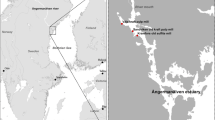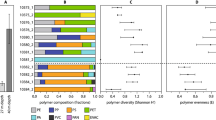Abstract
Purpose
Wood extractives in sediments originating from the wood industry may interfere with benthic biota in aquatic environments. The research area was the Äänekoski watercourse in Central Finland, which has been affected by the chemical wood industry for over a century. The goal was to determine the dissolution potency of resin acids (RAs) and their derivative, retene, in the sediment, and their current vertical and spatial stratification to assess the load due to potential erosion.
Materials and methods
Sediments were collected from two upstream reference sites and three lake-like basins, located as far as 33 km downstream from the mills. The dissolution potency was studied by two different agitation times and temperatures from sediment-water (1+4 v/v) elutriates. The vertical distribution of extractives was determined from the uppermost 20 cm of sediment. Using spatial interpolation, the distribution of extractives was estimated from two upper sediment layers (0–2 and 2–5 cm) downstream from the source. According to the interpolation, the total amount of dehydroabietic (DHAA) and isopimaric acids (IPA) were calculated as kg/ha in the whole sediment area.
Results and discussion
The total concentration of RAs in the surface sediment reached up to 168 µg/g dw, and they were found to desorb to water up to 77 µg/l. The concentrations of retene were low both in the sediment (<51 µg/g dw) and elutriate (<0.53 µg/l). Spatial interpolation showed that the highest calculated amounts of the most abundant RAs were in Kuhnamo basin, in the sediment layer 2–5 cm; the estimated amount of DHAA and IPA were approximately 440 and 85 kg/ha, respectively.
Conclusions
Disturbances may change the exposure situation, causing desorption of sediment-associated compounds in levels that may be harmful to aquatic animals. The amount of desorption varies depending on the concentration of contaminants in sediment, the nature of disturbance, and the sediment organic carbon content. Low retene concentrations can be explained by oxic conditions and low abundance of RAs in the sediments.




Similar content being viewed by others
References
Anonymous (2003) Suurtulvatyöryhmän loppuraportti (in Finnish). Työryhmämuistio MMM 2003:6, Helsinki, 126 p
Anonymous (2006) Äänekosken metsäteollisuusintegraatin jätevedenpuhdistamon ympäristölupa, Äänekoski (in Finnish). ISY-2004-Y-258, 48 p
Auer J (1971) Äänekosken tehtaat 75 vuotta (in Finnish). Simonpaino Oy, Tapiola, Finland, 208 p
Billiard SM, Querbach K, Hodson P (1999) Toxicity of retene to early life stages of two freshwater fish species. Environ Toxicol Chem 18:2070–2077
Brinkworth LC, Hodson PV, Tabash S, Lee P (2003) CYP1A induction and blue sac disease in early developmental stages of rainbow trout (Onchorhynchus mykiss) exposed to retene. J Toxicol Environ Health 66A:627–646
Chen W, Kan AT, Fu G, Vignon AC, Tomson M (1999) Adsorption – desorption behaviours of hydrophobic organic compounds in sediments of Lake Charles Louisiana, USA. Environ Toxicol Chem 18:161610–1616
Chen W, Kan AT, Fu G, Tomson M (2000) Factors affecting the release of hydrophobic organic contaminants from natural sediments. Environ Toxicol Chem 19:2401–2408
Eggleton J, Thomas KV (2004) A review of factors affecting the release and bioavailability of contaminants during sediment disturbance events. Environ Int 30:973–980
Hynynen J, Palomäki A, Meriläinen JJ, Witick A, Mäntykoski K (2004) Pollution history and recovery of a boreal lake exposed to a heavy bleached pulping effluent load. Journal Paleolim 32:351–374
Håkanson L, Jansson M (1983) Principles of lake sedimentology. Springer-Verlag, Berlin, 316 p
IPCC (2007) Climate change 2007: synthesis report. Contribution of working groups I, II and III to the fourth assessment report of the intergovernmental panel on climate change. In Pachauri RK, Reisinger A (eds), IPCC, Geneva, Switzerland, 104 p
Judd MC, Stuthridge TR, Tavendale MH, McFarlane PN, Mackie KL, Buckland SJ, Randall CJ, Hickey CW, Roper DS, Anderson SM, Steward D (1995) Bleached kraft pulp mill sourced organic chemicals in sediments from New Zealand rivers. Part 1: Waikato River. Chemosphere 30:1751–1765
Judd MC, Stuthridge TR, McFarlane PN, Anderson SM, Bergman I (1996) Bleached kraft mill sourced organic chemical in sediment from a New Zealand river. Part II: Tarawera River. Chemosphere 33:2209–2220
Karels A, Oikari A (2000) Effects of pulp and paper mill effluents on the reproductive and physiological status of perch (Perca fluviatilis) and roach (Rutilus rutilus) during the spawning period. Ann Zool Fennici 37:65–77
Kiparissis Y, Akhtar P, Hodson PV, Brown RS (2003) Partition-controlled delivery of toxicants: a novel in vivo approach for embryo toxicity testing. Environ Sci Technol 37:2262–2266
Lahdelma I, Oikari A (2005) Resin acids and retene in sediments adjacent to pulp and paper industries. J Soils Sediments 5:74–81
Lebo JA, Huckins JN, Petty JD, Cranor WL, Ho KT (2003) Comparisons of coarse and fine versions of two carbons for reducing the bioavailabilities of sediment-bound hydrophobic organic contaminants. Chemosphere 50:1309–1317
Leppänen H, Oikari AOJ (1999a) Occurrence of retene and resin acids in sediments and fish bile from a lake receiving pulp and paper mill effluents. Environ Toxicol Chem 18:1498–1505
Leppänen H, Oikari A (1999b) The biotransformation of dehydroabietic acid under anaerobic and aerobic conditions at different temperatures by a sedimental microbial consortium In: Leppänen H (1999) The fate of resin acids and resin-derivated compounds in aquatic environment contaminated by chemical wood industry. Jyväskylä studies in biological and environmental science 80, Jyväskylä, Finland, 149 p
Leppänen H, Oikari A (2001) Retene and resin acid concentrations in sediment profiles of a lake recovering from exposure to pulp mill effluents. J Paleolim 25:367–374
Matinvesi J (1996) The change of sediment composition during recovery of two Finnish lakes induced by waste water purification and lake oxygenation. Hydrobiologia 335:193–202
McMichael AJ, Woodruff RE, Hales S (2006) Climate change and human health: present and future risks – review. The Lancet 367:859–869
Meriläinen JJ, Hynynen J, Palomäki A, Veijola H, Witick A, Mäntykoski K, Granberg K, Lehtinen K (2001) Pulp and paper mill pollution and subsequent ecosystem recovery of large boreal lake in Finland: a paleolimnological analysis. J Paleolimnol 26:11–35
Meriläinen P, Lahdelma I, Oikari L, Hyötyläinen T, Oikari A (2006) Dissolution of resin acids, retene and wood sterols from contaminated lake sediments. Chemosphere 65:840–846
Meriläinen PS, Krasnov A, Oikari A (2007) Time and concentration-dependent metabolic and genomic responses to exposure to resin acids in brown trout (Salmo trutta m. lacustris). Environ Toxicol Chem 26:1827–1835
Meriläinen P, Oikari A (2008a) Exposure assessment of fishes to modern pulp and paper mill effluents after a black liquor spill. Environ Monit Assess 144:419–435
Meriläinen P, Oikari A (2008b) Uptake of organic xenobiotics by benthic invertebrates from sediment contaminated by the pulp and paper industry. Environ Wat Res 42:1715–1725
Oikari A, Lönn B-E, Castrén M, Nakari T, Snickars-Nikinmaa B, Bister H, Virtanen E (1983) Toxicological effects of dehydroabietic acid (DHAA) on the trout, Salmo gairdneri Richardson, in fresh water. Wat Res 17:81–89
Oikari A, Cherr NG, Hodson PV (2001) Dissolution, bioavailability and toxicity of retene in industrial sediment. Abstracts, ITC9 Congress in Brisbane, Australia, July 6–12, p 247
Ollila M, Virta H, Hyvärinen H (2000) Suurtulvaselvitys. Arvio mahdollisen suurtulvan aiheuttamista vahingoista Suomessa (in Finnish). Suomen ympäristö 441. Suomen ympäristökeskus, Helsinki, Finland. pp 8–36
Park SS, Ertsfeld KM (1999) The effect of sediment organic carbon content on bioavailability of hydrophobic compounds in aquatic ecosystems. Environ Pollut 105:9–15
Peng G, Roberts JC (2000) Solubility and toxicity of resin acids. Wat Res 34:2779–2785
Ristola T, Pellinen J, Leppänen M, Kukkonen J (1996) Characterization of Lake Ladoga sediments. I. Toxicity to Chironomus riparius and Daphnia magna. Chemosphere 32:1165–1178
SFS (1990) Determination of total residue and total fixed residue in water, sludge and sediment. Finnish Standards Association 3008, 3 p
Shepard D (1968) A two-dimensional interpolation function for irregularly spaced data. Proceedings ACM National Conference pp 517–523
Sjöström E (1993) Wood chemistry – fundamentals and applications, 2nd edn. Acad. Press (Ltd.), San Diego, 292 p
Tavendale MH, Wilkins AL, Langdon AG (1995) Analytical methodology for the determination of freely available bleached kraft mill effluent-derived organic constituents in recipient sediments. Environ Sci Technol 29:1407–1414
Tavendale MH, McFarlane PN, Mackie KL, Wilkins AL, Langdon AG (1997) The fate of resin acids-1. The biotransformation and degradation of deuterium labelled dehydroabietic acid in anaerobic sediments. Chemosphere 35:2137–2151
van den Heuvel MR, Landman MJ, Tremblay LA (2006) Responses of shortfin eel (Anguilla australis) exposed in situ to pulp and paper effluent. J Toxicol Environ Heatlh 69A:1763–1779
Acknowledgements
We would like to show our appreciation to the Academy of Finland for financing this project (7109823). In addition, we wish to thank Mervi Koistinen and Leena Siitonen for their technical assistance.
Author information
Authors and Affiliations
Corresponding author
Additional information
Responsible editor: Jan Schwarzbauer
Rights and permissions
About this article
Cite this article
Rämänen, H., Lassila, H., Lensu, A. et al. Dissolution and spatial distribution of resin acids and retene in sediments contaminated by pulp and paper industry. J Soils Sediments 10, 349–358 (2010). https://doi.org/10.1007/s11368-009-0179-5
Received:
Accepted:
Published:
Issue Date:
DOI: https://doi.org/10.1007/s11368-009-0179-5




